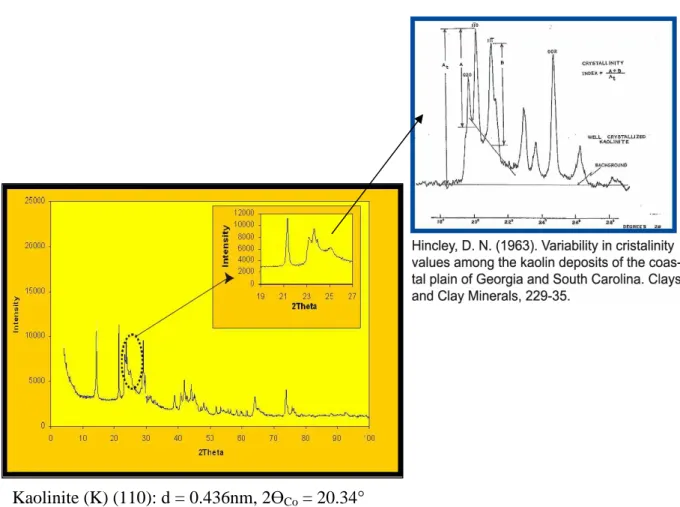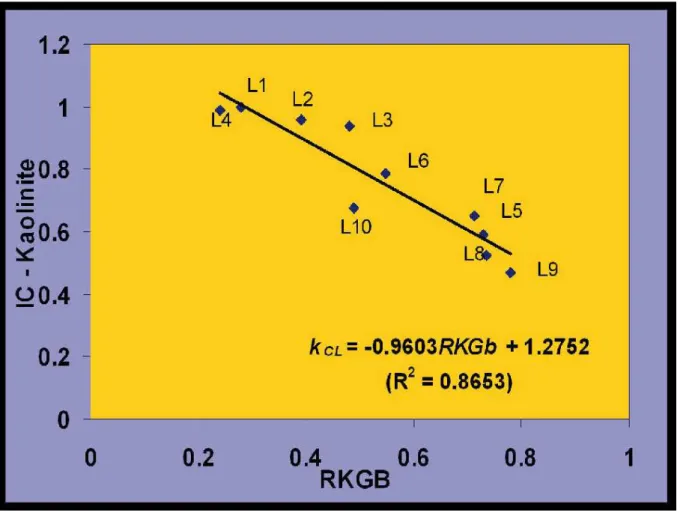HAL Id: insu-00311902
https://hal-insu.archives-ouvertes.fr/insu-00311902
Submitted on 22 Aug 2008HAL is a multi-disciplinary open access archive for the deposit and dissemination of sci-entific research documents, whether they are pub-lished or not. The documents may come from teaching and research institutions in France or abroad, or from public or private research centers.
L’archive ouverte pluridisciplinaire HAL, est destinée au dépôt et à la diffusion de documents scientifiques de niveau recherche, publiés ou non, émanant des établissements d’enseignement et de recherche français ou étrangers, des laboratoires publics ou privés.
Kaolinite cristalinity index of Latosols as environment
indicator of the Brazilian Central Plateau
geomorphologic surfaces
Adriana Reatto-Braga, Ary Bruand, Éder de Souza Martins, Fabrice Muller,
Philippe Penhoud, Euzebio Medrado da Silva, Michel Brossard
To cite this version:
Adriana Reatto-Braga, Ary Bruand, Éder de Souza Martins, Fabrice Muller, Philippe Penhoud, et al.. Kaolinite cristalinity index of Latosols as environment indicator of the Brazilian Central Plateau geomorphologic surfaces. European Clay Meetings, 22 to 27 july„ Jul 2007, Aveiro, Portugal. pp.253. �insu-00311902�
Kaolinite cristalinity index of Latosols as environment indicator of the Brazilian Central Plateau geomorphologic surfaces
Adriana Reatto1, 2, Ary Bruand2, Eder S. Martins1,Fabrice Muller2, Philippe Penhoud2, Euzébio M. Silva1, Michel Brossard3
1
Empresa Brasileira de Pesquisa Agropecuária (Embrapa Cerrados), BR 020, km 18, 73310-970, Planaltina, Distrito Federal, Brazil (Adriana.Reatto@univ-orleans.fr); 2 Institut des Sciences de la Terre d'Orléans (ISTO) UMR6113 CNRS/Université d'Orléans 1A, rue de la Férollerie 45071 Orléans, France Cedex 2; 3 Institut de Recherche pour le Développement (IRD), Unité Valpédo, BP 64501, 34394 Montpellier Cedex 5, France.
Communicating author: Adriana.Reatto@univ-orleans.fr, reatto@cpac.embrapa.br
The Brazilian Central Plateau is constituted of the South American Surface and Velhas Surface geomorphologic surfaces and represents 24% of the Brazilian territory. Latosols cover about 40% of these Surfaces. Kaolinite, gibbsite, goethite and hematite were recognized in different proportions in the clay fraction of Latosols by many authors. The objective of this work was to analyse the kaolinite cristalinity and to discuss its variability according to the Latosol location on the geomorphic Surfaces of the Brazilian Central Plateau.
Ten Latosols (L) developed in different parent materials were selected for study along an approximately 350 km long regional toposequence across the South American Surface (L1 to L4) and Velhas Surface (L5 to L10). Samples were collected in the diagnostic horizon (Bw) of these Latosols. Chemical composition obtained after dissolution in sulfuric acid was used to estimate the kaolinite, gibbsite, goethite and hematite content. Goethite and hematite content was also estimated using the soil color (hue, value and chrome). The mineralogical composition of the oriented < 2 µm fraction was also determined by using X-ray diffraction (Thermo Electron ARL`XTRA, Cu tube, 0.050 2θ step). The Hincley index (1963) was used to quantify the kaolinite cristalinity in the non-oriented clay fraction X-ray diffraction (INEL XR3000 transmission, Co monochromator, Co tube, sample inside a capillary 0.5mm in diameter, resolution 0.03), Figure 1.
Figure 1 – Example illustrating Hincley index in the clay fraction X-ray diffraction of
Latosols studied.
The results showed that the variation of the kaolinite cristalinity index (KCI) was closely related to the kaolinite/gibbsite (RKGb) ratio as shown by the following relationship:
KCI = -0.9603 RKGb + 1.2752 (R2 = 0.8653), (Figure 2)
They showed also a greater kaolinite cristalinity index and a smaller kaolinite/gibbsite ratio for the Latosols of the South American Surface (L1 to L4) than for those of the Velhas Surface.
Kaolinite (K) (110): d = 0.436nm, 2ӨCo = 20.34° Kaolinite (K) (111): d = 0.436nm, 2ӨCo = 21.59°
Figure 2 – Relationship between kaolinite cristalinity index (KCI) and kaolinite/gibbsite (RKGb) ratio for Latosols (L) of the Brazilian Central Plateau.

